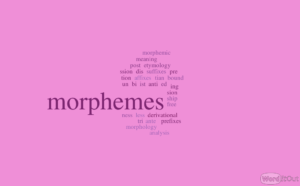What with one thing and another, there’s a lot of pressure on teachers today. Grammar and word study has suddenly assumed much greater proportions and one aspect of grammar somebody was asking me about the other day was morphology.
The conversation went like this:
Teacher: I’ve got to teach my class about morphology.
Me: Okay. What’s the problem with morphology?
Teacher: Nobody ever told me anything about it on my teacher training course.
This post is an attempt at an explanation.
More broadly speaking morphology is the study of form or structure. In linguistics, morphology is the study of words, of how they are formed and of what their relationship is to other words in the language. English is both synthetic or inflectional and agglutinative or affixing. Both of which can be subsumed under the heading ‘fusional’. Inflectional languages, such as Latin, add suffixes to indicate tense in verb forms and whether nouns are the subject or object in a sentence. In agglutinative languages, words contain spaces into which small, verbal elements can be placed. For example, in the word ‘unusually’, un- expresses the meaning ‘not’, and -ly shows that the word is an adverb.
Firstly, a morpheme is the smallest unit of sound that signifies meaning. You’d probably think that the smallest unit of meaning would be the word but this gives rise to a number of problems. For example, the words ‘swim’ and ‘swims’ are different, even though the words are clearly related and also follow a similar pattern to many other verbs in English. In English, we might say ‘I swim every morning’, but ‘Emma swims every morning’. In the first example, the word swim is what is called a free morpheme; in the second, the -s attached to swim is a bound morpheme.
Free and bound morphemes are mutually exclusive. ‘Swim’ is a free morpheme and can stand or occur alone; bound morphemes, like the -s, on the other hand, are not ‘free-standing’ and need to be bound or linked to other morphemes. The convention is to indicate this by using a hyphen to follow a morpheme that precedes another morpheme, such as in the word unhappy, in which the bound morpheme, a prefix, would be indicated un- (happy). Similarly, when a bound morpheme follows another morpheme, this is shown by a hyphen which precedes the bound morpheme, such as we see in the case of (swim) -s.
In English, words can be formed by combining morphemes to create new words. Here are some examples:
Compound words, such as stairlift and graveyard, combine two free morphemes.
Lightly is a combination of light and –ly, a free and a bound morpheme.
The example conjoin puts together the bound morpheme con– with the free morpheme join.
We can further distinguish between the two types of bound morpheme: inflectional and derivational.
Regular English verbs, such as film and limp, are free morphemes which provide a ‘base’ for inflections which change their meaning. Thus, we have films, filming and filmed, and limps, limping and limped. Similarly, nouns can be inflected to resonate a change in number and gender. [In languages, such as Spanish and Italian, pronouns and adjectives also inflect to indicate a change in number and gender.] So, an inflectional morpheme can change a verb’s tense, aspect, mood, person and number. However, inflections don’t change the basic meaning of the word.
Derivational morphemes, such as un- and -er, alter significantly the meaning of ‘base’ forms inasmuch as they form different words. For example, the meaning of ‘unimportant’ is the converse of ‘important’. Similarly, the addition of -er changes not only the meaning of a word but often the word class: for example, the verb ‘help’ becomes a noun ‘helper’ when the suffix -er is added.
I would expect anyone teaching phonics to begin introducing the idea of morphemes in the concrete context of teaching reading writing. At a fairly simple level, this is easy to do as, in the words of David Crystal, ‘most children give the impression of having assimilated of at least three quarters all the grammar there is to learn’ by the age of between four and five years. There is then a point at which the teaching of morphology can run in parallel to phonics teaching but it doesn’t precede phonics teaching and in fact, because of the complexity of conceptual understanding and the amount of code knowledge required to be learned, morphology shouldn’t be taught in tandem with phonics teaching when children are in the early stages of beginning to read.
When older children who have fallen behind and are being taught as an intervention, it goes without saying that bringing together phonics teaching with meaning, etymology, morphemic analysis, and so on, is likely to enhance interest while deepening knowledge. It’s what phonics teachers worth their salt have always done.

This was definitely something I had no thought about before! Personally, grammar was not that large a part of my studies when I was younger, mostly because teachers failed to teach me or failed to teach me well. I think your point on deepening the child's understanding using this method is very useful since they say the key to learning anything is prior knowledge. Learning the nitty gritty may seem tedious but surely pays off in the long run.
Have you considered morphology’s associations with comprehension? Kirby et al. (2012) studied the effects of morphological awareness on 103 children’s reading levels. Through gathering data on each child’s ability, Kirby et al. concluded that morphological awareness highly influences reading comprehension skills and thus it should obtain a high focus throughout all stages of schooling.
Kirby, J, R., Deacon, H, S., Bowers, P, N., Izenberg, L., Wade-Woolley, L. and Parrila, R. (2012) ‘Children's Morphological Awareness and Reading Ability’, Reading and Writing: An Interdisciplinary Journal, 25(2), pp.389-410.